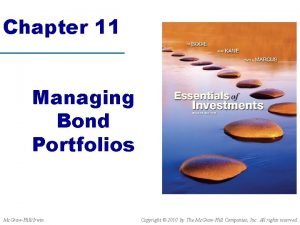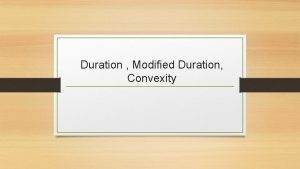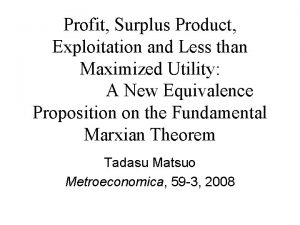S 802 16 m08578 Maximized MicroSleep Duration in






- Slides: 6

S 802. 16 m-08/578 Maximized Micro-Sleep Duration in Active Mode Document Number: S 802. 16 m-08/578 Date Submitted: July 7, 2008 Source: Ming-Hung Tao (minghung 02@gmail. com) Mamadou Kone (itri 404759@itri. org. tw) Ying-Chuan Hsiao (ychsiao@itri. org. tw) Richard Li (richard 929@itri. org. tw ) ITRI Venue: Denver, USA Base Contribution: IEEE C 802. 16 m-08/578 r 1 Purpose: For discussion and approval by TGm. Notice: This document does not represent the agreed views of the IEEE 802. 16 Working Group or any of its subgroups. It represents only the views of the participants listed in the “Source(s)” field above. It is offered as a basis for discussion. It is not binding on the contributor(s), who reserve(s) the right to add, amend or withdraw material contained herein. Release: The contributor grants a free, irrevocable license to the IEEE to incorporate material contained in this contribution, and any modifications thereof, in the creation of an IEEE Standards publication; to copyright in the IEEE’s name any IEEE Standards publication even though it may include portions of this contribution; and at the IEEE’s sole discretion to permit others to reproduce in whole or in part the resulting IEEE Standards publication. The contributor also acknowledges and accepts that this contribution may be made public by IEEE 802. 16. Patent Policy: The contributor is familiar with the IEEE-SA Patent Policy and Procedures: <http: //standards. ieee. org/guides/bylaws/sect 6 -7. html#6> and <http: //standards. ieee. org/guides/opman/sect 6. html#6. 3>. Further information is located at <http: //standards. ieee. org/board/pat-material. html> and <http: //standards. ieee. org/board/pat >.

Motivations • In 16 m frame structure, since the long synchronization / SFH interval (possibly 20 ms) may not allow MS to have short power -off duration in sleep mode or idle mode, micro-sleep mechanism allowing MS to sleep in few subframes is required. • The 16 m hierarchical control structure can greatly benefit the design of micro-sleep mechanism.

Micro-sleep mechanism • Micro-sleep mechanism is applied to an MS operating in the active mode of the connected state. • MS shall turn off unused hardware modules after receiving the control message from the BS until the specified time for data accessing or the next control message arrives. • Currently, an MS must keep tracking every downlink control block to know its allocated access region. – micro-sleep duration is too short to have significant power saving gain. • To increase the micro-sleep duration, the MS has to decrease the frequency of decoding control blocks. – Obtain the subframe information such as subframe type and characteristic in the Superframe Header (SFH).

Maximize the micro-sleep duration

Subframe configuration in SFH Subframe usage code Description 1 16 m DL subframe 2 16 m UL subframe 3 16 e DL subframe 4 16 e UL subframe 5 Low-latency service subframe 6 High-latency service subframe 7 E-MBS subframe 8 High mobility subframe 9 Relay subframe 10 General DL subframe 11 General UL subframe 12~16 Reserved

Proposed Text (see contribution C 80216 m-08_578 r 1)











